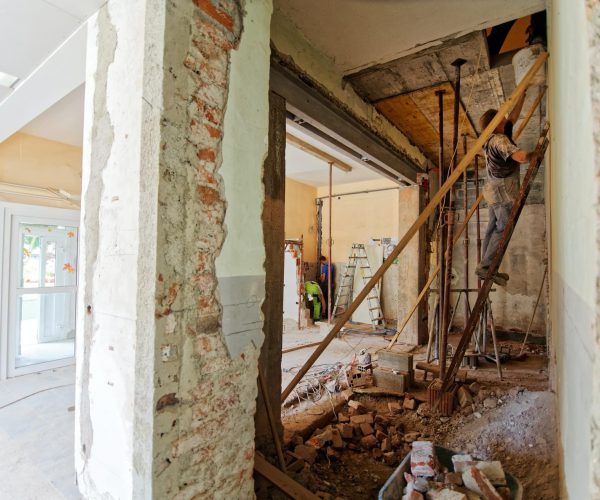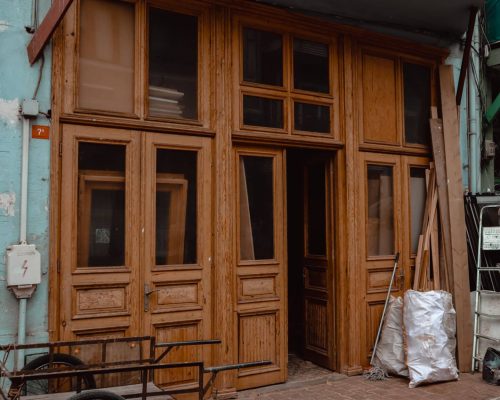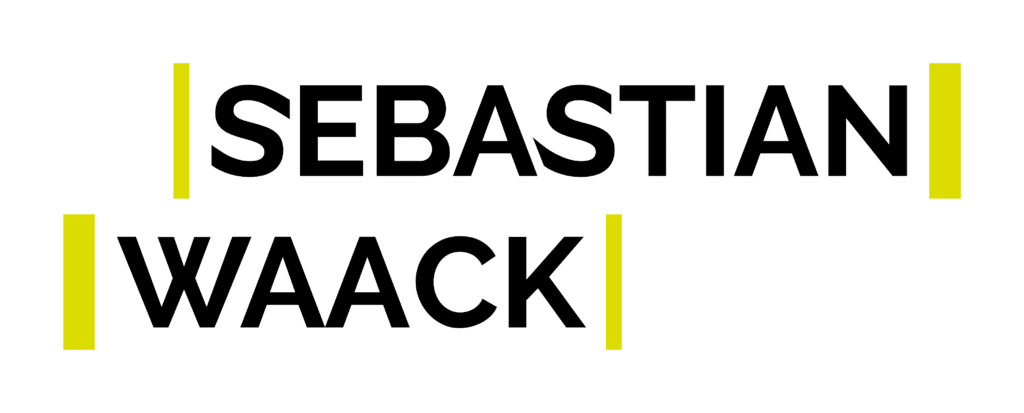More turnover. More profit. More time.
Process optimization for the building renovation industry
Do you know the problems too?
- Insufficient communication between departments
- Lack of documentation of processes and procedures
- Insufficient control over processes and costs
Stay relaxed. I have a solution.
Finally more success:
Process optimization
is your key for
better operations
Nice to have you back
Let's together
on your problems
work.
Refurbishers know the pitfalls of the trade. Structured processes and the latest technology make the difference. Increase quality and reduce uncertainties. Sebastian Waack refines your building refurbishment.
Building renovation comes with its own challenges. Not least due to communication problems, incomplete documentation and unforeseen hurdles.
But this is exactly where process optimization comes in. Sebastian Waack has developed a feel for the special features of the refurbishment sector. He focuses on efficient employee management, progressive digitalization strategies and outstanding quality management.
Just imagine: All refurbishment projects run like clockwork, are completed on time and without budget overruns.
Less trouble, more success stories. Are you ready to transform your processes?

Work Results:
Sebastian Waack helped a construction company from the Rhineland to strengthen the communication of its departments through the use of modern communication tools and regular team meetings.
For a renovation project in Bavaria, Sebastian Waack introduced comprehensive documentation software that recorded the entire renovation process, minimizing sources of error and making workflows more transparent.
In Hesse, Sebastian Waack worked together with a building renovator and integrated high-performance monitoring systems. This led to precise cost control and prevented expensive delays in the project.
- Process documentation
- Digitization
- Inventory Management
- Employee development
- Quality management
Solution 1

For a good renovation project, the departments need to talk to each other well. If they don’t, there are often misunderstandings and everything takes longer.
Sebastian Waack uses new tools to make talking between teams easier.
He uses programs where everyone can immediately see how the project is going. Sebastian also organizes meetings and workshops so that everyone can work together better.
If the team is well informed, everything goes faster and the result is better.
A successful renovation project requires seamless communication between departments. Without a clear exchange, misunderstandings and delays can occur.
Sebastian Waack uses modern communication tools to facilitate the flow of information between the teams.
He uses platforms that enable real-time feedback and collaborative planning, providing clarity on project status at all times. In addition to these tools, Sebastian relies on internal workshops and meetings that promote interdisciplinary exchange.
A better informed team means fewer delays and higher project quality.
Solution 2

A good renovation project needs clear records. Without these records, errors can occur.
Sebastian Waack uses a special program that records everything in detail.
This helps to keep track of everything and ensure that there is always a plan in place, even if employees change or problems arise.
Sebastian regularly checks that everything is written down correctly. So everyone can see exactly what has been done.
Solid documentation is the backbone of any refurbishment operation. Without clear records, errors and inefficiencies can occur.
Sebastian Waack implements advanced documentation software that records the entire process from start to finish.
This not only makes tracking easier, but also ensures that a clear schedule is always available in the event of staff changes or unexpected challenges.
The documentation is always kept up to date through regular audits and reviews. This means that every step remains transparent and traceable.
Solution 3

Unexpected costs and delays can cause problems when refurbishing buildings.
Sebastian Waack uses special systems to keep a close eye on the work and the money.
With certain programs, he can quickly find out where there are problems and fix them.
Sebastian also gives courses to help the teams manage money and time better. This saves money and the work is completed on time.
Unplanned costs and process delays can have a significant impact on building refurbishment.
Sebastian Waack relies on high-performance monitoring systems that track both the physical progress of the work and the budget in real time.
With analysis tools that uncover performance bottlenecks, it is possible to intervene quickly and take corrective action before major problems arise.
Sebastian also conducts training sessions to help teams better manage budgets and schedules. The result is greater cost efficiency and punctual project completion.
What do I mean by...
More details about the building blocks
Process documentation
Process documentation in the building renovation industry: clear structures, smooth processes. Every detail recorded, every measure planned. Renovate with vision!
Quality management
Quality management in the building renovation industry: perfection meets sustainability. Highest standards maintained, every project flawless. Refurbishment at the highest level!
Inventory Management
Inventory & supply chain management in the building refurbishment industry: synchronization meets precision. Every material tracked, every delivery on time. Refurbishment without delay!
Digitization
Digitalization in the building renovation industry: technology meets tradition. Every process digitally recorded, every innovation integrated. Refurbishment in the age of 4.0!
Employee development
Employee development in the building renovation industry: talent promotes quality. Every skill trained, every success visible. Teams that are built for tomorrow!
What is currently the biggest challenge in your building refurbishment company?
I'm thinking... give me 5 seconds ...
Real case studies of my work as a process optimizer in the building refurbishment industry
A renowned refurbishment company from Stuttgart was facing a dilemma: despite an increasing number of orders, profits were stagnating. The construction site employees often felt overwhelmed as they had to work with unclear instructions and without sufficient training on new techniques and materials. This led to quality problems, which in turn required costly reworking.
The company hired Sebastian Waack to solve these problems. He held in-depth discussions with everyone involved – from the management to the construction site employees. It became clear that the main problem was the lack of employee development and training. Many errors resulted from ignorance of new methods and the use of the wrong materials.
Sebastian realized that investing in employee development and training was crucial. He implemented a comprehensive training program that included both theoretical and practical modules. This included training on new technologies, material science and best practices in building refurbishment. In addition to training, he introduced a mentorship program in which experienced employees acted as mentors to younger colleagues. This not only promoted the transfer of specialist knowledge, but also strengthened team spirit and communication within the crews. To measure the progress and effectiveness of these programs, Sebastian implemented feedback mechanisms and regular quality checks.
The effects were impressive: within six months, rework was reduced by over 40% and customer satisfaction increased significantly. By investing in its employees, the Stuttgart-based company has not only been able to improve the quality of its work, but also increase its profitability and consolidate its reputation as an industry leader.
A renowned refurbishment company from Stuttgart was facing a dilemma: despite an increasing number of orders, profits were stagnating. The construction site employees often felt overwhelmed as they had to work with unclear instructions and without sufficient training on new techniques and materials. This led to quality problems, which in turn required costly reworking.
The company hired Sebastian Waack to solve these problems. He held in-depth discussions with everyone involved – from the management to the construction site employees. It became clear that the main problem was the lack of employee development and training. Many errors resulted from ignorance of new methods and the use of the wrong materials.
Sebastian realized that investing in employee development and training was crucial. He implemented a comprehensive training program that included both theoretical and practical modules. This included training on new technologies, materials science and best practices in building refurbishment. In addition to training, he introduced a mentorship program in which experienced employees acted as mentors to younger colleagues. This not only promoted the transfer of specialist knowledge, but also strengthened team spirit and communication within the crews. To measure the progress and effectiveness of these programs, Sebastian implemented feedback mechanisms and regular quality checks.
The effects were impressive: within six months, rework was greatly reduced and customer satisfaction increased significantly. By investing in its employees, the Stuttgart-based company has not only been able to improve the quality of its work, but also increase its profitability and consolidate its reputation as an industry leader.
Contact: I am looking forward to your message

Your direct line to me.
I look forward to your message and will get back to you as soon as possible.
- Bremen & online via Zoom
- inquiry@sebastianwaack.de
- +49 (0) 176-414 862 64
FAQs
-
Process optimization in building refurbishment involves improving workflows, methods and practices in order to achieve more efficient, cost-effective and high-quality implementation of refurbishment projects. This can relate to the planning phase, the implementation of refurbishment work, the use of technology or compliance with regulations and standards, such as the German Energy Saving Ordinance (EnEV) and DIN standards.
-
Process optimization is important in order to improve the quality of the renovation work, shorten the project duration, reduce costs and increase customer satisfaction. More efficient workflows and processes can also prevent misunderstandings and errors and thus reduce expensive rework.
-
A process optimizer analyzes existing processes and workflows, identifies weaknesses and develops solutions to improve them. This can be done by using modern technologies, improving communication and coordination within the team or through training to improve compliance with standards and regulations.
-
Process optimization can help to ensure compliance with standards and regulations, such as the German Energy Saving Ordinance (EnEV) and DIN standards. Improved documentation, monitoring and training can keep everyone involved up to date with the latest regulations and prevent errors.
-
Through more efficient workflows, better planning and coordination and the use of modern technologies, process optimization can help to save time and use resources more effectively. This can reduce the cost of materials, labor and rework, thus lowering the overall cost of the renovation project.
-
Typical challenges in building refurbishment can include inefficient communication, lack of coordination, missed schedules, high costs and compliance issues. Process optimization can help solve these challenges through better planning and coordination, efficient workflows and improved compliance with standards and regulations.
-
An efficient and well-coordinated renovation leads to faster completion of the project, a higher quality of work and better adherence to the budget. All of this helps to increase customer satisfaction. In addition, process optimization can ensure better communication and reporting to the customer, which leads to greater transparency and trust.
-
Process optimization can help to improve the quality of work in building refurbishment through improved workflows, the use of modern technologies and methods, and training in compliance with standards and regulations. This can lead to a more durable and effective renovation and avoid expensive reworking.
-
Technology can play a decisive role in process optimization. Modern software can help with the planning and coordination of refurbishment projects, while technological innovations in refurbishment, such as thermal imaging cameras or specialized refurbishment tools, can improve the efficiency and quality of the work.
-
The first step is to analyze the existing processes and workflows and identify areas that can be improved. A process optimizer can help carry out this analysis and develop a plan for optimization. Technology, training and improved communication and coordination strategies can be used.
-
In the long term, process optimization can help to increase the efficiency and quality of work, increase customer satisfaction and reduce costs. This can promote the growth and profitability of the company and lead to a better reputation in the industry.
-
A good process optimizer also offers support after the optimization has been completed. This may include answering questions, providing additional training or helping to solve problems. The aim is to ensure that the improved processes function effectively.

